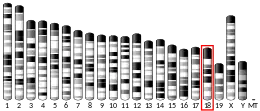ELAC1
Zinc phosphodiesterase ELAC protein 1 is an enzyme that in humans is encoded by the ELAC1 gene.[5][6]
| ELAC1 | |||||||||||||||||||||||||||||||||||||||||||||||||||
|---|---|---|---|---|---|---|---|---|---|---|---|---|---|---|---|---|---|---|---|---|---|---|---|---|---|---|---|---|---|---|---|---|---|---|---|---|---|---|---|---|---|---|---|---|---|---|---|---|---|---|---|
| |||||||||||||||||||||||||||||||||||||||||||||||||||
| Identifiers | |||||||||||||||||||||||||||||||||||||||||||||||||||
| Aliases | ELAC1, D29, elaC ribonuclease Z 1 | ||||||||||||||||||||||||||||||||||||||||||||||||||
| External IDs | OMIM: 608079 MGI: 1890495 HomoloGene: 10272 GeneCards: ELAC1 | ||||||||||||||||||||||||||||||||||||||||||||||||||
| |||||||||||||||||||||||||||||||||||||||||||||||||||
| |||||||||||||||||||||||||||||||||||||||||||||||||||
| |||||||||||||||||||||||||||||||||||||||||||||||||||
| |||||||||||||||||||||||||||||||||||||||||||||||||||
| |||||||||||||||||||||||||||||||||||||||||||||||||||
| Wikidata | |||||||||||||||||||||||||||||||||||||||||||||||||||
| |||||||||||||||||||||||||||||||||||||||||||||||||||
Function
The enzyme is a phosphodiesterase.
References
- GRCh38: Ensembl release 89: ENSG00000141642 - Ensembl, May 2017
- GRCm38: Ensembl release 89: ENSMUSG00000036941 - Ensembl, May 2017
- "Human PubMed Reference:". National Center for Biotechnology Information, U.S. National Library of Medicine.
- "Mouse PubMed Reference:". National Center for Biotechnology Information, U.S. National Library of Medicine.
- Takaku H, Minagawa A, Takagi M, Nashimoto M (Apr 2003). "A candidate prostate cancer susceptibility gene encodes tRNA 3' processing endoribonuclease". Nucleic Acids Res. 31 (9): 2272–8. doi:10.1093/nar/gkg337. PMC 154223. PMID 12711671.
- "Entrez Gene: ELAC1 elaC homolog 1 (E. coli)".
Further reading
- Gerhard DS, Wagner L, Feingold EA, et al. (2004). "The status, quality, and expansion of the NIH full-length cDNA project: the Mammalian Gene Collection (MGC)". Genome Res. 14 (10B): 2121–7. doi:10.1101/gr.2596504. PMC 528928. PMID 15489334.
- Ota T, Suzuki Y, Nishikawa T, et al. (2004). "Complete sequencing and characterization of 21,243 full-length human cDNAs". Nat. Genet. 36 (1): 40–5. doi:10.1038/ng1285. PMID 14702039.
- Strausberg RL, Feingold EA, Grouse LH, et al. (2003). "Generation and initial analysis of more than 15,000 full-length human and mouse cDNA sequences". Proc. Natl. Acad. Sci. U.S.A. 99 (26): 16899–903. Bibcode:2002PNAS...9916899M. doi:10.1073/pnas.242603899. PMC 139241. PMID 12477932.
- Yanaihara N, Kohno T, Takakura S, et al. (2001). "Physical and transcriptional map of a 311-kb segment of chromosome 18q21, a candidate lung tumor suppressor locus". Genomics. 72 (2): 169–79. doi:10.1006/geno.2000.6454. PMID 11401430.
- Tavtigian SV, Simard J, Teng DH, et al. (2001). "A candidate prostate cancer susceptibility gene at chromosome 17p". Nat. Genet. 27 (2): 172–80. doi:10.1038/84808. PMID 11175785. S2CID 7889550.
- Suzuki Y, Yoshitomo-Nakagawa K, Maruyama K, et al. (1997). "Construction and characterization of a full length-enriched and a 5'-end-enriched cDNA library". Gene. 200 (1–2): 149–56. doi:10.1016/S0378-1119(97)00411-3. PMID 9373149.
- Maruyama K, Sugano S (1994). "Oligo-capping: a simple method to replace the cap structure of eukaryotic mRNAs with oligoribonucleotides". Gene. 138 (1–2): 171–4. doi:10.1016/0378-1119(94)90802-8. PMID 8125298.
This article is issued from Wikipedia. The text is licensed under Creative Commons - Attribution - Sharealike. Additional terms may apply for the media files.




